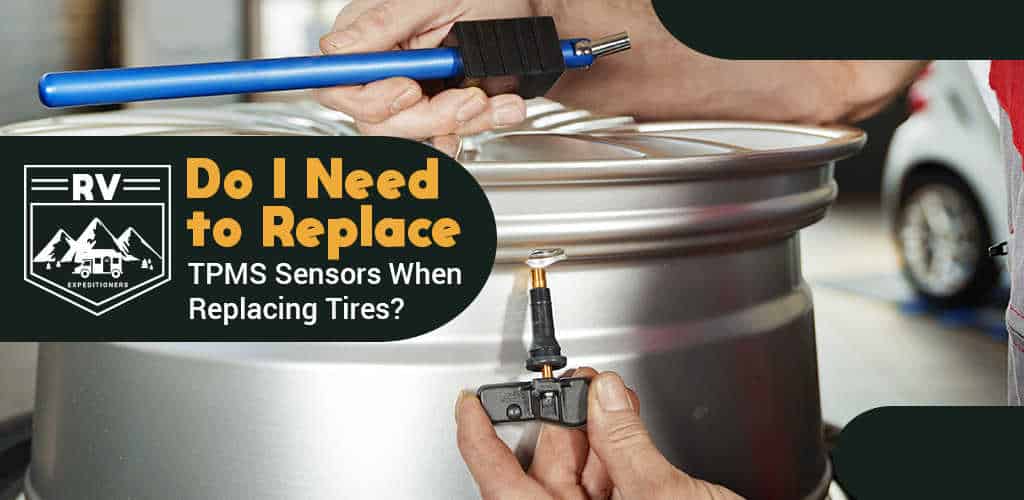A lot of drivers ask this question probably because they don’t understand how TPMS sensors are calibrated. Because of their positioning, it may make sense at first that when you replace your old tires, you could also replace the TPMS sensors.
However, TPMS sensors can be recalibrated for different tires and even different wheel sizes. Depending on the make and model of your camper, this may or may not be an easy process, but that doesn’t mean that changing tires and tire pressure sensors go hand in hand.
That’s not to say that under certain circumstances, you can’t do both at the same time. Here’s what you need to know.
TPMS Sensors Battery Life
TPMS sensors are equipped with permanent batteries. This means that eventually a complete replacement of the system will be necessary. However, it’s important to understand that the service life of the lithium-ion batteries inside TPMS sensors can be 5 to 10 years.
The lifespan may be lower if your RV has older TPMS sensors, as low as six years max. But, you can’t always easily determine whether your sensors are due for a replacement. You have to keep in mind that TPMS sensors don’t work full time.
They are designed to preserve battery life such that the sensors only measure and send out signals in intervals. The only time when they do use more power is when something is wrong and they send signals to your onboard computer.
If the sensor battery happens to run out when you’re buying new tires, then yes, the TPMS sensors should also be replaced. If not, you may still want to look at other factors that affect the performance of the sensors.
What Warrants a TPMS Sensor Replacement?
One of the most common reasons is corrosion. If you don’t have a snap-in TMPS sensor (the ones that come with rubber valve stems), then corrosion becomes a problem. Road salt is one of the main reasons why TPMS sensor valves corrode.
Physical damage to the TPMS sensors is also a concern. Their positioning makes them susceptible to damage from accidents, going over potholes, getting a flat tire, etc.
As mentioned, a dead battery is another reason why you should change your sensors. Of course, depending on the type of sensors, you may have to replace the entire system or individual sensors.
One last thing to consider is the remaining battery life. If you’re certain that you’re due for a TPMS sensor replacement in a couple of months or so, you can save money by replacing the sensors at the same time as your tires. You will save the labor cost at least.
TPMS Sensors Can Be Recalibrated for New Tires
Generally, TPMS sensors can be reset to 0 and recalibrated for your new tires. If you don’t want to do this at the shop, you can use a TPMS reset tool to reset the sensors on your own.
It’s usually recommended that you go a few miles at 50 mph to allow the sensors to fully calibrate and learn the behavior of the new tires. This is a good habit to have whether you’re replacing your tires or just recalibrating your sensors to resolve any onboard alerts.
But driving a few miles may not be enough for some RVs. You may have to consider the possibility of having to electronically reset the TPMS sensors after changing your tires. In some cases, you can do this by pressing the reset button.
In rarer situations, you may need a proper diagnostic tool for your RV to reset the sensors.
How Do They Change the Sensors After Replacing Tires?
Not all repair shops will actually change your TPMS sensors after replacing your tires. Some will recommend servicing the sensors or rebuilding them to some degree. This usually means that the mechanics will replace the valve core, nut, seal, and protective cap that goes over the valve stem.
Of course, some mechanics will probably try to convince you to change all the TPMS sensors. They’ll come up with guidelines line every other time you change tires or some such excuse. But, as previously mentioned, you may not need replacement or servicing if your sensors are working properly.
Can I reuse TPMS on new wheels?
If the tire pressure monitoring sensors come with your vehicle, they can definitely be reused. It is important to exercise caution when removing the sensors from your wheels because they are fragile and easily damaged. You can avoid such hassles and headaches by purchasing OE TPMS.
Final Thoughts
Making sure that your sensors are always operating at their best is important. Low tire pressure can often lead to accidents, so whenever the warning light turns on, you should check the tire’s PSI regardless.
Remember that not all TPMS sensors will pinpoint exact tires. Indirect tire pressure measuring systems or iTPMS sensors will trigger a warning light for any one or all of your tires.
But, if you’re confident that your sensors are working properly and you know how to reset and recalibrate your sensors, then you may not have to change the TPMS sensors at the same time as your tires.
If after reading this article you're decided to get your TPMS substituted, make sure to check our article where we review the best units available in the market here.

